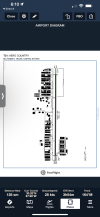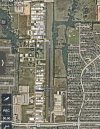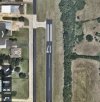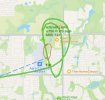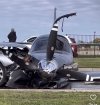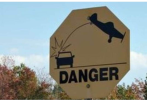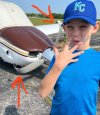You are using an out of date browser. It may not display this or other websites correctly.
You should upgrade or use an alternative browser.
You should upgrade or use an alternative browser.
Lancair in McKinney 11/11/23
- Thread starter donjohnston
- Start date
Thunderbird83
Pre-Flight
- Joined
- Apr 12, 2013
- Messages
- 46
- Display Name
Display name:
Thunderbird83
On another group, someone posted that it was a loss of pressurization at 25,000‘. Unconfirmed.
Morgan3820
En-Route
I thought that they had drag chutes . Anyway, looks real expensive. Guessing the guy in the car that got hit is lawyering up.
. Anyway, looks real expensive. Guessing the guy in the car that got hit is lawyering up.
 . Anyway, looks real expensive. Guessing the guy in the car that got hit is lawyering up.
. Anyway, looks real expensive. Guessing the guy in the car that got hit is lawyering up.Kenny Phillips
Final Approach
- Joined
- Jul 29, 2018
- Messages
- 5,499
- Display Name
Display name:
Kenny Phillips
A relatively minor bump.I thought that they had drag chutes. Anyway, looks real expensive. Guessing the guy in the car that got hit is lawyering up.
RyanShort1
Final Approach
As noted elsewhere, it does look like he was using the brakes - plenty of smoke there!
Zeldman
Touchdown! Greaser!
Guessing the guy in the car that got hit is lawyering up
I don't know, looked like the car hit the airplane to me... shouldn't a crashing airplane have the right of way.??

More importantly no injuries.!!

donjohnston
Pattern Altitude
N751HP Flight Tracking and History - FlightAware
Track N751HP flight from Midland Airpark to Aero Country
Roland Donnell
Pre-Flight
Wonder if the guys on the 12th green at Westridge took a stroke off their golf card.
jbDC9
Pre-takeoff checklist
Possibly, but that isn’t what caused the overrun…On another group, someone posted that it was a loss of pressurization at 25,000‘. Unconfirmed.
DavidWhite
Final Approach
Was the loss of pressurization related to an engine failure?
jbDC9
Pre-takeoff checklist
In looking at the linked FlightAware flight profile, I'd say nope. Looks like they were at FL250 for a short while, then descended to 9500-ish and continued to Aero Country.Was the loss of pressurization related to an engine failure?
texasclouds
En-Route
Whoopsie
Aero Country has 4300’ ish runway, but the northern part is turf. Wonder if pilot was unfamiliar and/or unwilling to use the (very smooth) turf portion?
Omalley1537
Cleared for Takeoff
- Joined
- Mar 13, 2015
- Messages
- 1,345
- Display Name
Display name:
Sean
Clearly the car driver didn’t have his wife with him…otherwise she would have been yelling at him to brake before the plane even touched down…
Lindberg
Final Approach
Do airplanes regularly use it now? When I flew there in the '90s, only the gliders used it. But I was flying Cessnas for which 3,000' was more than enough.Aero Country has 4300’ ish runway, but the northern part is turf. Wonder if pilot was unfamiliar and/or unwilling to use the (very smooth) turf portion?
SixPapaCharlie
May the force be with you
- Joined
- Aug 8, 2013
- Messages
- 16,034
- Display Name
Display name:
Sixer
I have seen it used quite a bit. Mostly by Husky's, cubs, and similar types.Do airplanes regularly use it now? When I flew there in the '90s, only the gliders used it. But I was flying Cessnas for which 3,000' was more than enough.
Lindberg
Final Approach
That makes sense. Are they using it exclusively or as an extension of the pavement?I have seen it used quite a bit. Mostly by Husky's, cubs, and similar types.
benyflyguy
En-Route
Almost looks like porpoising.
Flyer Scott
Pre-Flight
- Joined
- Oct 31, 2022
- Messages
- 31
- Display Name
Display name:
Flyer Scott
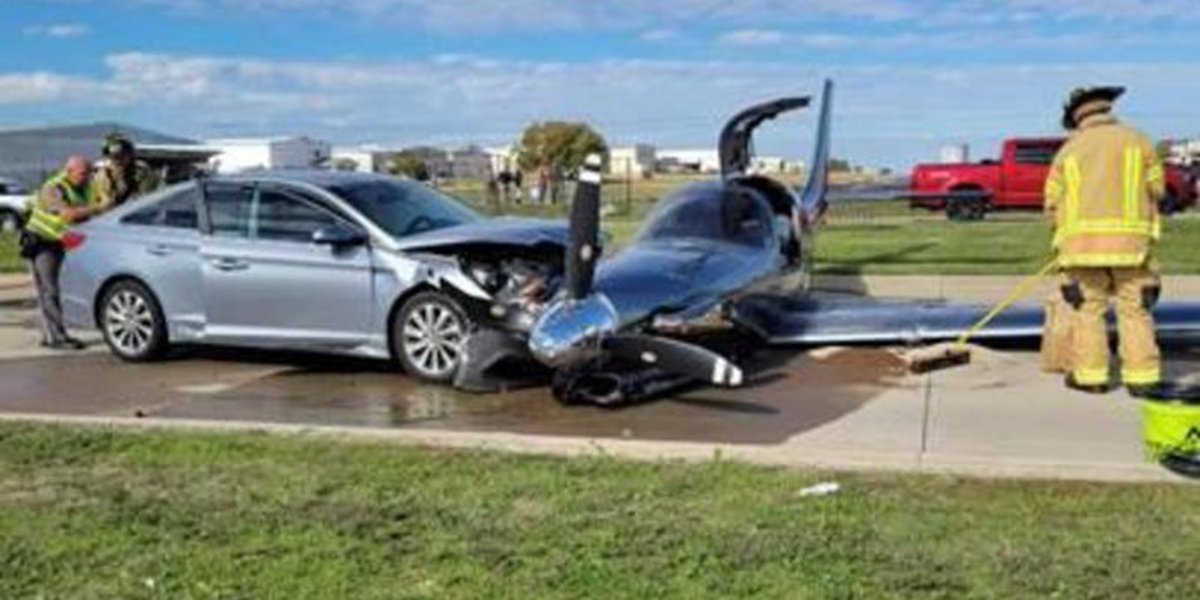
Small plane crashes into car in McKinney, 1 injured
The roadway is expected to be closed for hours.
Accident Lancair IV-P Propjet N751HP,
A Charles Hayes experimentally built Lancair IV-P Propjet, N751HP, sustained substantial damage when it was involved in a runway excursion and collision with a motor vehicle at Aero Count...
aviation-safety.net
francisco collazos
Pre-takeoff checklist
- Joined
- Jun 11, 2021
- Messages
- 354
- Display Name
Display name:
ciscovet
I read somewhere where the prop reversal wasn't working. I have never heard of that. Is that a thing?
hindsight2020
Final Approach
- Joined
- Apr 3, 2010
- Messages
- 6,726
- Display Name
Display name:
hindsight2020
yes, beta on turbo props is a thing.
Apparently beta in pistons is also a thing...

 www.pilotsofamerica.com
www.pilotsofamerica.com
Beta in a piston?
donjohnston
Pattern Altitude
Can confirm. A guy in Summerland key had one on his Velocity. He could get on the ground and stopped in less than 1,000'. Which is pretty amazing for an XL-RG.Apparently beta in pistons is also a thing...

Beta in a piston?
www.pilotsofamerica.com
Inthegoo
Filing Flight Plan
- Joined
- Nov 15, 2023
- Messages
- 5
- Display Name
Display name:
Jason Ianiro
Heres what I noticed:
The airport diagram and the runway tab say the runway is 4352 feet long, BUT…… the paved portion is only 3000 feet (see below)
The turf part of the runway is the north portion and N751HP landed south, now take a look at the satellite photos (see below)
This pilot was already shaken up from the pressurization emergency that ended 45 minutes earlier, one of the reports I read said that this was the first time this pilot had been to this airport, Im thinking he/she may have been aiming for the numbers (as is natural) and was actually leaving 1352 feet of the runway behind them.
In an amazing coincidence I was in fredricksburg texas on nov 5 and was admiring this exact airframe parked on the ramp (N751HP) I looked over this amazing airplane for a few minutes and one thing I remember about it was that the landing gear, especially the nose gear was terribly flimsy looking, I would imagine the engineers had overall weight front of mind on this design and did not have much room to have a super beefy landing gear. Saying that I would bet that the high landing speeds associated with this small wing high performance P51 wanna bee combined with the small landing gear, probably prohibit this airplane from ever landing on turf.
So is 3000 feet of pavement enough for this airplane?
Did the pilot know he/she was actually only looking at 3000 feet? Did they think it was 4352 of pavement?
I am a retired airline pilot of 23 years, ive been flying 35 years, at the airlines we are trained to be highly alert for secondary mistakes after one emergency has ended on a particular flight, we even will brief that, meaning after lets say this pressurization problem would have happened to us we would be at 10000 feet and recognize the emergency is over but would state out loud to each other that we are highly susceptible to making unrelated mistakes during the rest of this flight and or the rest of this flight day.
I cast no stones at this pilot, they did the best they could.
Also my disclaimer is the standard one that all of this is speculation and its for speculation sake and discussion only, the faa will do its thing and they will probably uncover way more, I am very anxious to follow this one and see what turns up.
Im glad everyone was unhurt, I hope this pilot returns to the skies.
The airport diagram and the runway tab say the runway is 4352 feet long, BUT…… the paved portion is only 3000 feet (see below)
The turf part of the runway is the north portion and N751HP landed south, now take a look at the satellite photos (see below)
This pilot was already shaken up from the pressurization emergency that ended 45 minutes earlier, one of the reports I read said that this was the first time this pilot had been to this airport, Im thinking he/she may have been aiming for the numbers (as is natural) and was actually leaving 1352 feet of the runway behind them.
In an amazing coincidence I was in fredricksburg texas on nov 5 and was admiring this exact airframe parked on the ramp (N751HP) I looked over this amazing airplane for a few minutes and one thing I remember about it was that the landing gear, especially the nose gear was terribly flimsy looking, I would imagine the engineers had overall weight front of mind on this design and did not have much room to have a super beefy landing gear. Saying that I would bet that the high landing speeds associated with this small wing high performance P51 wanna bee combined with the small landing gear, probably prohibit this airplane from ever landing on turf.
So is 3000 feet of pavement enough for this airplane?
Did the pilot know he/she was actually only looking at 3000 feet? Did they think it was 4352 of pavement?
I am a retired airline pilot of 23 years, ive been flying 35 years, at the airlines we are trained to be highly alert for secondary mistakes after one emergency has ended on a particular flight, we even will brief that, meaning after lets say this pressurization problem would have happened to us we would be at 10000 feet and recognize the emergency is over but would state out loud to each other that we are highly susceptible to making unrelated mistakes during the rest of this flight and or the rest of this flight day.
I cast no stones at this pilot, they did the best they could.
Also my disclaimer is the standard one that all of this is speculation and its for speculation sake and discussion only, the faa will do its thing and they will probably uncover way more, I am very anxious to follow this one and see what turns up.
Im glad everyone was unhurt, I hope this pilot returns to the skies.
Attachments
My neigbhor had beta on his Seabee, but I'm pretty sure it was placarded as not to be used in flight.
Yes, barely, without beta 3000 would be enough. I have a 2 seat lancair with similar landing speeds. I can do 3000 no wind landings but prefer longer and will be on alert when going into a runway that short. I could easily see not being so focused if thinking I had 4500 feet.So is 3000 feet of pavement enough for this airplane?
Inthegoo
Filing Flight Plan
- Joined
- Nov 15, 2023
- Messages
- 5
- Display Name
Display name:
Jason Ianiro
By the way, bravo to this pilot for executing the go around on the first try, im curious as to why the go around? If you look at the adsb ground track from flightaware (i have pasted it below) the first go around is offset, (meaning the pilot was never lined up with the runway, and thats curious? Was the first pass just a look see at the unfamiliar airport? At first i thought maybe so, but then i noticed the airport passes off the right side of the airplane and it’s unlikely the pilot is sitting in the right seat so thats probably not the explanation, so this was probably just a regular (unstable approach) go around. Bravo to the pilot for making this choice to go around, as we see in too many accidents pilots, even professionals ones are unfortunately reluctant to choose to go around when its appropriate because they just too focused on completing the mission and dont see the go around as something other then a failure on their part, the go around is actually a success and should be celebrated. Really!
Why are prop blades not q tipped? Meaning when a prop is spinning and it digs into the ground or pavement it curls under, this prop doesnt show that in the post accident video, (see photo below) does that mean it was not spinning? Or at least not producing thrust? I admit thats outside my wheelhouse. Its too bad the video of the crash didnt start just one frame earlier because you could look for this if it did.
Why are prop blades not q tipped? Meaning when a prop is spinning and it digs into the ground or pavement it curls under, this prop doesnt show that in the post accident video, (see photo below) does that mean it was not spinning? Or at least not producing thrust? I admit thats outside my wheelhouse. Its too bad the video of the crash didnt start just one frame earlier because you could look for this if it did.
Attachments
aggie06
Line Up and Wait
This wasn’t a Lancair. It is based on a Lancair but has different wings and different stabs. The manufacturer advertises much lower approach and landing speeds, along with only 1000 feet landing distance (which I assume requires functional beta on the prop).Yes, barely, without beta 3000 would be enough. I have a 2 seat lancair with similar landing speeds. I can do 3000 no wind landings but prefer longer and will be on alert when going into a runway that short. I could easily see not being so focused if thinking I had 4500 feet.
aggie06
Line Up and Wait
I’ve seen the video of the approach and landing. It was producing thrust all the way. He floated past the 1/2 sign on that runway before touching down, with a single porpoise in the first half of the runway. He locked up the tires almost immediately and still went through the ditch and the fence, and into the street. Manufacturer’s published landing distance still should have been enough if everything was functional though.By the way, bravo to this pilot for executing the go around on the first try, im curious as to why the go around? If you look at the adsb ground track from flightaware (i have pasted it below) the first go around is offset, (meaning the pilot was never lined up with the runway, and thats curious? Was the first pass just a look see at the unfamiliar airport? At first i thought maybe so, but then i noticed the airport passes off the right side of the airplane and it’s unlikely the pilot is sitting in the right seat so thats probably not the explanation, so this was probably just a regular (unstable approach) go around. Bravo to the pilot for making this choice to go around, as we see in too many accidents pilots, even professionals ones are unfortunately reluctant to choose to go around when its appropriate because they just too focused on completing the mission and dont see the go around as something other then a failure on their part, the go around is actually a success and should be celebrated. Really!
Why are prop blades not q tipped? Meaning when a prop is spinning and it digs into the ground or pavement it curls under, this prop doesnt show that in the post accident video, (see photo below) does that mean it was not spinning? Or at least not producing thrust? I admit thats outside my wheelhouse. Its too bad the video of the crash didnt start just one frame earlier because you could look for this if it did.
aggie06
Line Up and Wait
I think this was an LX7, which the manufacturer says can stop in 800 feet. That’s awful short, but would be doable in half the 3000 feet of pavement. According to the AOPA article, that means new wings and new vertical stab/rudder.A IVPT is a lancair 4p with turbine conversion. Can't land halfway down a 3k foot runway in one of these and expect to get stopped before runway end.
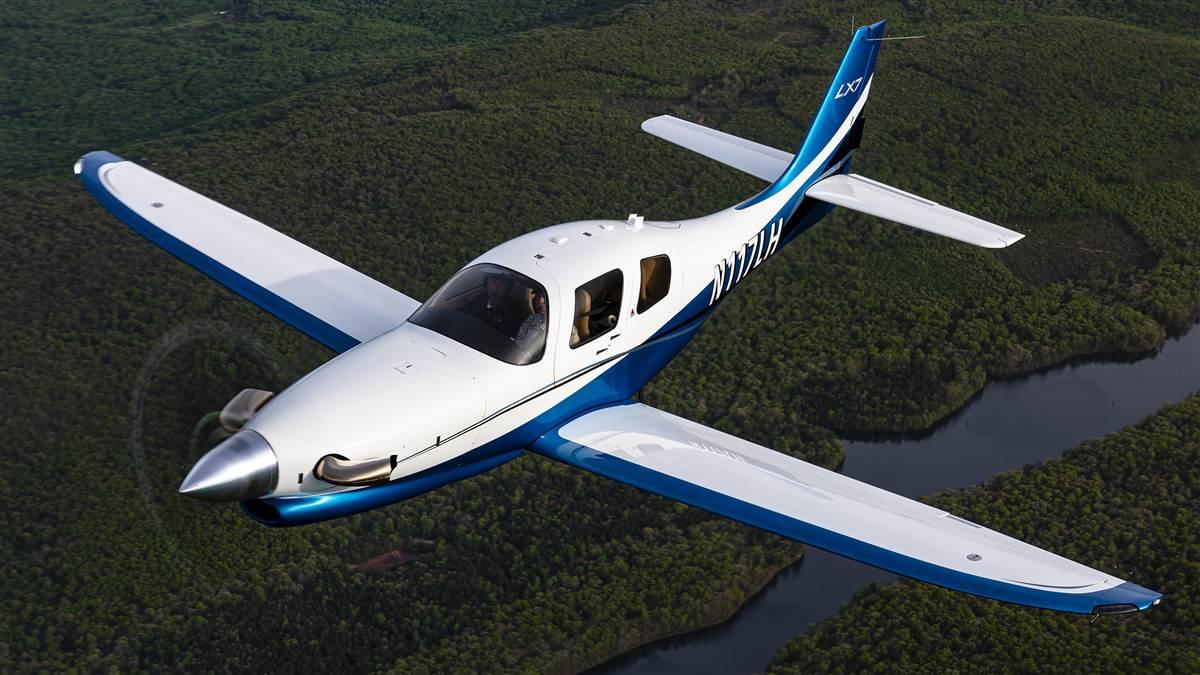
Raw energy
The pre-takeoff trim settings provide some not-so-subtle clues about the fury about to be unleashed.
www.aopa.org
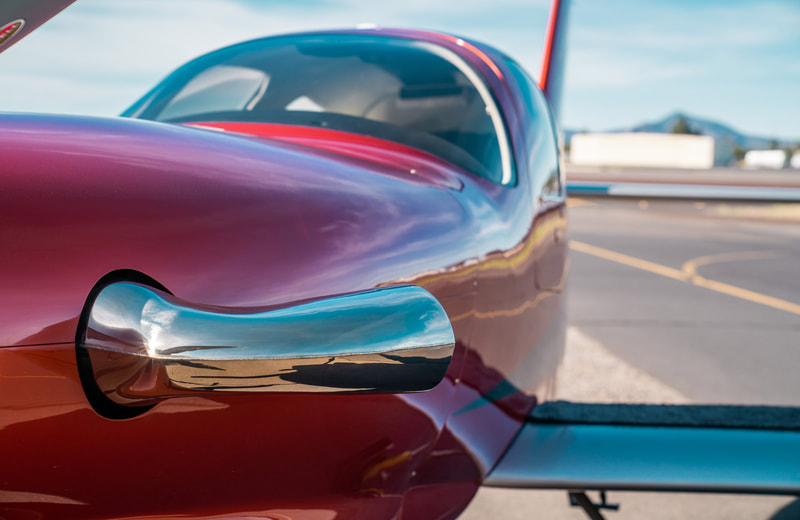
Someone sent it to me. It’s from the east side of the runway and you can hear the cameraman going “not good not good not good” for most of the float.Omg where is the full video you reference? I wanna see that!
Inthegoo
Filing Flight Plan
- Joined
- Nov 15, 2023
- Messages
- 5
- Display Name
Display name:
Jason Ianiro
Can you attach it here or send it to me plz? ThxI think this was an LX7, which the manufacturer says can stop in 800 feet. That’s awful short, but would be doable in half the 3000 feet of pavement. According to the AOPA article, that means new wings and new vertical stab/rudder.

Raw energy
The pre-takeoff trim settings provide some not-so-subtle clues about the fury about to be unleashed.www.aopa.org
Someone sent it to me. It’s from the east side of the runway and you can hear the cameraman going “not good not good not good” for most of the float.
RyanShort1
Final Approach
What, are they towing gliders there, now, too?New sign for the road next to the airport...
View attachment 122457
NTSB Prelim:
"According to the pilot, while at flight level 250 west of Abilene, Texas, a door seal failed, and the airplane experienced a loss of pressurization... About 5 minutes after establishing cruise flight at 10,000 ft to T31, the pilot noted an amber caution light for the propeller RPM...During the downwind leg, the pilot pulled back the power lever and the lever ball (see figure 1) came off in his hand..."
And then it gets weirder:
"The pilot stated the airplane touched down in the first 500 ft of the runway without a float or a bounce in ground effect, and he immediately “hit [the] brakes gently” and maintained the runway centerline. For about 5 to 10 seconds, the pilot unsuccessfully attempted to move the power lever into beta-reverse."
However:
"A review of the video showed the airplane touch down and bounce near the 1⁄2 point of the 3,002 ft asphalt runway. All three landing gear came to rest on the runway surface and evidence of braking action (smoke from main landing gear wheels/tires) occurred about 3 seconds later. The wheel/tire smoke continued until the airplane exited the runway surface.
According to the T31 airport manager, who examined the runway surface after the accident, the first visible tire skid marks were about 200 ft past the 1⁄2 point of the runway. The skid marks remained visible for about 1,300 ft until the airplane departed the end of the asphalt"
"According to the pilot, while at flight level 250 west of Abilene, Texas, a door seal failed, and the airplane experienced a loss of pressurization... About 5 minutes after establishing cruise flight at 10,000 ft to T31, the pilot noted an amber caution light for the propeller RPM...During the downwind leg, the pilot pulled back the power lever and the lever ball (see figure 1) came off in his hand..."
And then it gets weirder:
"The pilot stated the airplane touched down in the first 500 ft of the runway without a float or a bounce in ground effect, and he immediately “hit [the] brakes gently” and maintained the runway centerline. For about 5 to 10 seconds, the pilot unsuccessfully attempted to move the power lever into beta-reverse."
However:
"A review of the video showed the airplane touch down and bounce near the 1⁄2 point of the 3,002 ft asphalt runway. All three landing gear came to rest on the runway surface and evidence of braking action (smoke from main landing gear wheels/tires) occurred about 3 seconds later. The wheel/tire smoke continued until the airplane exited the runway surface.
According to the T31 airport manager, who examined the runway surface after the accident, the first visible tire skid marks were about 200 ft past the 1⁄2 point of the runway. The skid marks remained visible for about 1,300 ft until the airplane departed the end of the asphalt"
Lindberg
Final Approach
Not that weird, really. Humans are terrible observers and even worse rememberers.NTSB Prelim:
"According to the pilot, while at flight level 250 west of Abilene, Texas, a door seal failed, and the airplane experienced a loss of pressurization... About 5 minutes after establishing cruise flight at 10,000 ft to T31, the pilot noted an amber caution light for the propeller RPM...During the downwind leg, the pilot pulled back the power lever and the lever ball (see figure 1) came off in his hand..."
And then it gets weirder:
"The pilot stated the airplane touched down in the first 500 ft of the runway without a float or a bounce in ground effect, and he immediately “hit [the] brakes gently” and maintained the runway centerline. For about 5 to 10 seconds, the pilot unsuccessfully attempted to move the power lever into beta-reverse."
However:
"A review of the video showed the airplane touch down and bounce near the 1⁄2 point of the 3,002 ft asphalt runway. All three landing gear came to rest on the runway surface and evidence of braking action (smoke from main landing gear wheels/tires) occurred about 3 seconds later. The wheel/tire smoke continued until the airplane exited the runway surface.
According to the T31 airport manager, who examined the runway surface after the accident, the first visible tire skid marks were about 200 ft past the 1⁄2 point of the runway. The skid marks remained visible for about 1,300 ft until the airplane departed the end of the asphalt"

